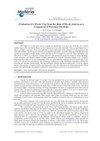Soybean hull as an alternative biosorbent to uptake a reactive textile dye from aqueous solutions
IF 1.2
4区 材料科学
Q4 MATERIALS SCIENCE, MULTIDISCIPLINARY
引用次数: 3
Abstract
The textile industries are responsible for generating large volumes of effluents containing toxic dyes, harmful to ecosystems if disposed of without prior treatment. The adsorption process stands out due to its simplicity and efficiency in removing a wide variety of contaminants present in effluents, also, it allows the use of residual biomass from agriculture. The soybean hull is a by-product of wide available but made used only for animal feed. Thus, the present study aimed to characterize and evaluate the soybean husk as a biosorbent of the 5G blue reactive dye, widely used in the dyeing processes of the textile industries. The soybean hull was characterized by SEM and FTIR. Kinetic and equilibrium tests were carried out under conditions of pH 2, 40 oC, and 90 rpm. Besides, kinetic and equilibrium mathematical models previously described in the literature were adjusted to the experimental data. Through the morphological characterization of the biosorbent, it was possible to evidence superficial pores in practically all their extension, a characteristic that directly influences the adsorption process. The analysis of FTIR showed, as expected, the presence of functional groups characteristic of lignocellulosic substances. Besides, the results obtained in the kinetic and equilibrium essays in the studied conditions show that the adsorption equilibrium was obtained in about 120 min, with the removal of 88% of the dye. The mathematical modeling indicated that the pseudo-second order and Sips models were the most adequate to represent the kinetic and equilibrium experimental data, respectively. The maximum adsorption capacities calculated experimentally and predicted by the Sips model were 53.33 and 48.13 mg g-1, respectively. In general, the biosorbent studied was effective to remove the reactive dye. Keywords: textile effluent; biosorption; agroindustrial waste.大豆壳作为生物吸附剂从水溶液中吸收活性纺织染料
纺织工业产生了大量含有有毒染料的废水,如果未经事先处理,将对生态系统有害。吸附过程因其简单和有效地去除废水中存在的各种污染物而脱颖而出,同时,它允许使用农业残留的生物质。大豆壳是一种广泛使用的副产品,但仅用于动物饲料。因此,本研究旨在表征和评价大豆壳作为5G蓝色活性染料的生物吸附剂,5G蓝色活性染料广泛用于纺织工业的染色过程。利用扫描电镜(SEM)和红外光谱(FTIR)对大豆外壳进行了表征。动力学和平衡试验在pH 2、40℃和90 rpm条件下进行。此外,根据实验数据对先前文献中描述的动力学和平衡数学模型进行了调整。通过生物吸附剂的形态表征,有可能证明表面毛孔几乎所有的延伸,这是一个直接影响吸附过程的特征。FTIR分析表明,正如预期的那样,存在木质纤维素物质特征的官能团。此外,在所研究的条件下,动力学和平衡论文的结果表明,在120 min左右达到吸附平衡,染料去除率达到88%。数学模型表明,拟二阶模型和Sips模型分别最适合表征动力学和平衡实验数据。Sips模型预测的最大吸附量和实验计算的最大吸附量分别为53.33和48.13 mg g-1。总的来说,所研究的生物吸附剂对活性染料的去除效果较好。关键词:纺织废水;生物吸附;农业的和工业的废物。
本文章由计算机程序翻译,如有差异,请以英文原文为准。
求助全文
约1分钟内获得全文
求助全文
来源期刊

Materia-rio De Janeiro
MATERIALS SCIENCE, MULTIDISCIPLINARY-
CiteScore
1.00
自引率
25.00%
发文量
51
审稿时长
6 weeks
期刊介绍:
All the articles are submitted to a careful peer-reviewing evaluation process by the journal''s Editorial Board. The Editorial Board, reviewers and authors make use of a web based proprietary automated tool to deal with the reviewing procedures.the Revista Matéria''s article reviewing restricted access system - SEER. Authors are not informed about the identity of the reviewers.
 求助内容:
求助内容: 应助结果提醒方式:
应助结果提醒方式:


